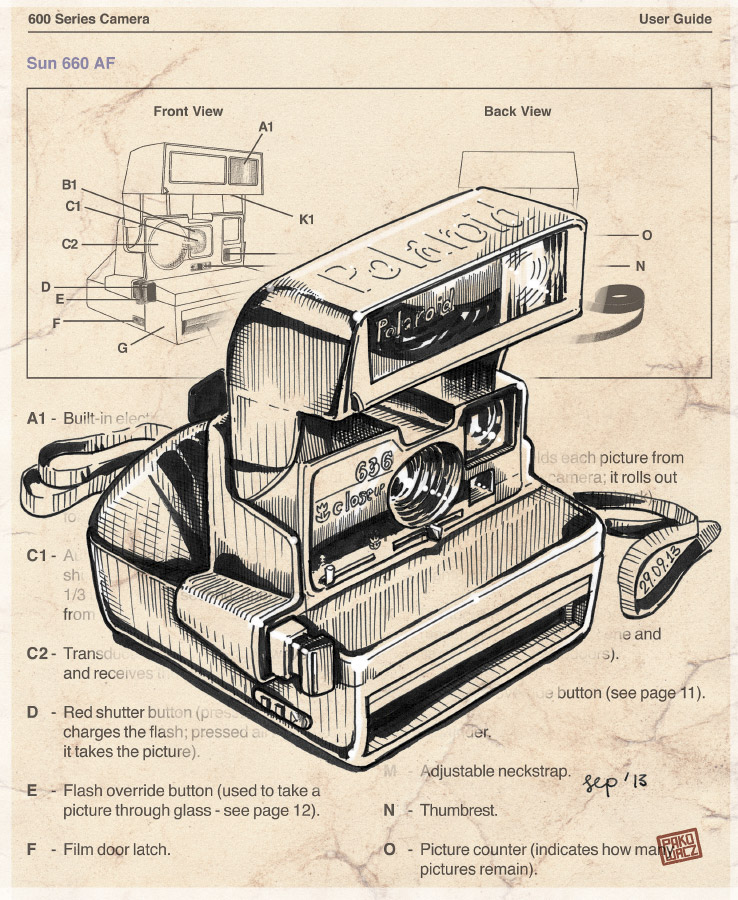When most people talk about Polaroid cameras, they mean the popular and relatively cheap models of the 1980s and 1990s that used film packs with integral batteries that were designated the 600 series. The "instant" prints measure 79mm (3.1") square with a white border around them and take around 3 minutes to fully develop at 70°F (21°C). The film has an ISO rating of 640. The film was branded with several different names over the years, including "Extreme 600" and "Notepad". A high definition "professional" film named "779" could also be used with cameras from the 600 series. Some of the cameras had 'sonar' autofocus and/or featured glass lenses, but most had plastic lenses with a fixed focus of around 4 feet. A "close-up" lens was often included, but this took the form of a simple plastic meniscus that slid into place. Many of the models are functionally identical to others but have different coloured fascia, names and stickers according to marketing territory. Several models were limited editions with tie-ins to icons of popular culture, such as Barbie or the Spice Girls, while other versions were promotional items made for corporate entities and are now highly collectible thanks to their rarity. - NA


Rolleiflex is the name of a long-running and diverse line of high-end cameras originally made by the German company Franke & Heidecke, and later Rollei-Werk. The "Rolleiflex" name is most commonly used to refer to Rollei's premier line of medium format twin lens reflex (TLR) cameras.
The Rolleiflex TLR film cameras were notable for their exceptional build quality, compact size, modest weight, superior optics, durable, simple, reliable mechanics and bright viewfinders. They were popular and widely imitated. The high-quality 8 cm focal length lenses, manufactured by Zeiss and Schneider, allowed for a smaller, lighter, more compact camera than their imitators. The highly regarded Zeiss Planar f2.8 and Schneider Xenotar lenses, both 80mm focal length and fast in comparison, are both state of the art optics. Unique to the Rolleiflex Automat and letter model cameras, the mechanical wind mechanism was robust and clever, making film loading semi-automatic and quick. This mechanism started the exposure counter automatically, auto-spaced the 12 or 24 exposures, and tensioned the shutter; all with less than one full turn of the film advance crank. This makes the Rolleiflex Automat/Letter model cameras very sought-after for shooting fast paced action, such as street photography[citation needed]. A wide range of accessories made this camera a system: panorama head, sun shade, parallax-corrected close-ups lenses, color correction, contrast enhancing, and special effect filters, all mounted with a quick release bayonet, as well as a quick-change tripod attachment. Some amateur and fine-art photographers still shoot Rolleiflex TLR film cameras with color transparency, color negative, or black-and-white film. The later f2.8 and f3.5 letter models (Planar or Xenotar lens) are highly sought after in the used market, and command the greatest price. Rolleiflex TLRs are still manufactured in Germany by DHW Fototechnik. Historically there were five focal length cameras available including 5.5 cm Rollei-Wide, 6.0 cm Baby Rollei, 7.5 cm (f:3.5), 8.0 cm (f2.8), and 13.5 cm (f:4 Zeiss Sonnar) Tele-Rolleiflex. Although all Rolleflex cameras can be fine user cameras, there is also an active market for many Rolleiflex models as collectables, and this adds (greatly in some models) to the end price paid, particularly in Japan - wiki


Zenit (Russian: Зени́т) is a Russian (and formerly Soviet) camera brand manufactured by KMZ in the town of Krasnogorsk near Moscow since 1952 and by BelOMO in Belarus since the 1970s. The Zenit trademark is associated with 35mm SLR cameras. Among related brands are Zorki for 35mm rangefinder cameras, Moskva (Moscow) and Iskra for medium-format folding cameras and Horizon for panoramic cameras. In the 1960s and 1970s, they were exported by Mashpriborintorg to 74 countries.

Kiev is a Soviet brand of photographic equipment including cameras manufactured by the Arsenal Factory in Kiev, Ukraine. The camera nameplates show the name "KIEV", with older cameras using "КИЕВ" (in Russian language) or "КИЇВ" (in Ukrainian language) in Cyrillic.
The Kiev-30 is a subminiature camera of Soviet production. For transport in the vest pocket it is collapsible to 3/4 of its size. On the camera back is a two slice analog calculator for shutter/aperture determination with ASA-valueand weather symbols as input variables. Its concept is a little like that of the Minolta-16, but it has the advantage of having a third thumb-wheel for focusing that appears when the camera is opened for use. - http://camerapedia.wikia.com


thank you for watching :)

